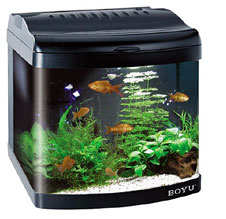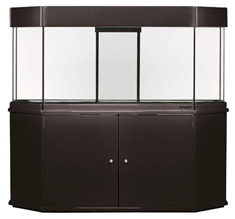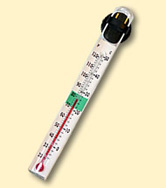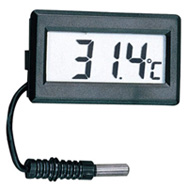

Aquarium Setup
The aquarium is a unique system, incorporating a large number of processes. The
outcome of this system is the visual form of the aquarium. In case the aquarium
works correctly, it will look marvelous. In case of troubles and faults in its operation,
all the aquarium inhibitors will be affected.
Early and proper planning of the aquarium, will lead to the wanted outcome. This
article highlights the questions to be dealt with before purchasing the equipment.
Topics in this article:
The size of the tank will be set considering budget and the location it will be
placed. Nowdays, it is possible to customize an aquarium for almost every location.
The aquariums come in a large variety of shapes and sizes.
A common mistake of beginning ornamental fish growers is starting with a small aquarium,
in order to lower the chances for error. The opposite is true. The bigger the aquarium
is, the more “forgiving” it will be for errors.
In most cases, standard, pre manufactured aquariums will be cheaper then personally
customized, built-to order aquariums.
Also, we must choose the shape of the tank by its purpose. For example, for a flora
aquarium is best to have a relatively low height (50 CM). The reason: the higher
the tank, the harder it is for the lighting to reach the lower parts of the aquarium.
It is recommended to consult us on the subject of matching the tank type to its
purpose.

|

|

|
|
Rounded Corners
|
Panoramic
|
Flat Back Hexagon Aquarium
|
Before we choose the aquarium we’d like to buy, we will choose the location we’d
like to place it. Remember, when the aquarium is full it is impossible, and not
safe to move it even a few centimeters. The location must be chosen thoroughly.
The most important rule is to prevent direct sunlight hitting the aquarium. The
direct exposure to sunlight is going to facilitate the growth of algae and, subsequently,
greening of the water and the walls. It is preferable to place the aquarium in such
a spot, where the only lighting is an artificial, controllable, light source.
Another important rule is to keep the aquarium away from heat-emitting sources.
For example. The reasons we would like to keep the aquarium away from heat sources
are:
- Extreme warming of the glass (occasionally followed by a cool-down) might cause
cracks, and harm the silicon holding the glass together.
- Extreme temperature change in the aquarium (up or down) make the fauna go into stress,
and might risk their lives.
Due to the high weight of the aquarium, much thought must be invested in the selection
of the stand on which he will stand on. The stand is available in two different
materials: Iron and wood.
Before we place the aquarium on the stand, we will place a Styrofoam layer, at least
one centimeter thick.
Besides the visual effect the hood has on the look of the aquarium, it has a few
additional important advantages:
- Prevention of dust and litter entering the aquarium.
- The Prevention of fast water evaporation, especially in the winter when the water
is heated.
- Allowing a comfortable placement of the lighting, without dazzling the aquarium
beholder.
Most of the hood types in existence today, are comfortable to use, unlike in the
past. Now days, all hoods come with openings in the back, allowing to route the
plumbing and electrical wiring out of the aquarium. Additionally, there are models
of hoods (mostly those who are purpose built for rounded edge aquariums) who contain
built in filters, and a number of electrical sockets, allowing us to minimize the
number of wires coming out of the aquarium.
In the case of aquariums with strong lighting, it is recommended to plan the hood
so there will be an option to install a ventilation system, able to cool the aquarium
in times when the water temperature rises above the wanted level. Such ventilation
can be done by installing ventilators that will lower the air temperature at the
hood, and by doing so will lower the water temperature, aswell.
The aquarium substrate has two possible roles:
- Ornamental purposes- Creating a prettier, more natural picture of the aquarium for
the beholder.
- For the flora- In the case of natural plants being planted, their needs must be
provided by the soil.
The substrate can be shaped in different forms. It can be made out of gravel sold
in different colors, stream pebbles, shredded shells, etc.
Sea sand cannot be used as a substrate. Sea sand contains large amounts of salts
that may harm the fish and flora. The water pressure turns the sea sand to a layer,
making it very hard for the plants to strike root and develop in the aquarium. Additionally,
burrowing fish looking for food will raise sand clouds.
In case we would like to install a flora aquarium, off course we would like the
plants to look at their best. A good looking plant always points at the fact that
the plant gets everything he needs from the environment to develop properly. Today,
it is possible to find a variety of substrate materials, made for the purpose of
natural flora growing. These products contain organic substances of all the nutrients
the plant needs.
With time, organic waste piles up onto the bottom of the aquarium. Such waste contains
mostly food remains, fish feces, and dead plants. In order to prevent this process
from harming the life in the aquarium, it is recommended to install a substrate
heating cable, which will create water circulation at the bottom and by doing so
will accelerate the discomposure process of the organic waste. We will adjust the
heating cable according to the length and width of the aquarium. The bigger the
measurements of the aquarium are the longer heating cable we will need.
The height of the substrate varies by the needs of the aquarium. In an aquarium
with aquatic vegetation, it is recommended that the bottom of the aquarium will
be at least 10 centimeters high. In an aquarium without vegetation, a substrate
5 CM high will suffice.
The wanted temperatures in the aquarium are directly influenced by the type of fish
he is inhibited by.
Most of the fish originate from tropical countries. In these aquariums, we will
keep a steady temperature of 25-28 degrees Celsius, constantly.
The heating will be achieved by adding a heater. Nowadays, all heaters contain a
built-in thermostat, which is responsible for regulating the heater so he will heat
up the water up to a wanted temperature, and not beyond.
Different heaters are available for purchase, with different power ratings, meant
for differently sized aquariums. The heater with the bigger power wattage will match
the aquarium with the bigger volume.
|
Power rating (Watt)
|
Aquarium volume (liters)
|
|
100
|
70-100
|
|
150
|
75-200
|
|
200
|
100-250
|
|
300
|
150-350
|
In case your aquariums volume exceeds 350 liters, it is possible to install two
heaters that will work simultaneously.
Seldomly, we will buy a device and discover that the device measures in Fahrenheit
degrees and not in calculus degrees. It is possible to convert the two measuring
methods without any difficulties.
Fahrenheit calculation = F =(C*9/5) + 32
Calculus calculation = C = (F – 32) * 5/9
To regulate the operation of the heater, a thermometer must be used. Today there
is a variety of variation of this product. The most common types are:

|

|

|
|
Glass thermometer
|
Sticker thermometer
|
Digital thermometer
|
In order to accelerate the water oxidation process, we need to use an aerator, which
will create turbulence in the water. The air pump is connected via a tube to an
air rock. The purpose of the air rock is to turn the airflow coming from the pump
into a large number of small air bubbles. By this action, we achieve two goals:
- Increasing the surface of the air coming into contact with the water.
- Mixing the water. The upper part of the aquarium, the one coming into contact with
the air, will be always more oxidized.
Air pumps with different power ratings and outlet numbers can be found. According
to the size of the aquarium we will decided on the power rating of the pump. The
bigger the aquarium, the more aeration will be needed. Nowadays, most of the pumps
come with an adjuster, allowing setting the amount of airflow the pump produces.
Besides the power of the air-pump, we must put an emphasis (especially if the aquarium
is located in the bedroom) to the noise the pump produces. The higher-quality pumps
are noticeably quieter compared to the simpler (mostly Chinese) pumps. Due to the
very low relative share of the overall aquarium price, it is recommended to invest
in a quiet, reliable pump which will serve the user for a long time.
In a floral aquarium with a carbon dioxide system, we will make sure to have a controlled
amount of this gas in the water. Using the photosynthesis process, the plants absorb
this gas and emit oxygen. That’s why, during the hours the aquarium lighting is
on, there is no need to activate the air pump, and it is even recommended not to
do so. Activation of the pump will result in an increase in the evaporation rate
of the carbon dioxide from the water.

Warning
|
If you notice the fish raising to the upper part of the aquarium and breathing
heavily, it is a sign to a low oxidation level. You must increase the power of the
air pump, and even add additional air-rocks, if necessary.
|
Artificial lighting is better because it is controllable and adjustable. The need
for lighting in the aquarium comes from two needs:
- In the visual sense, a lighted aquarium is more beautiful. The lighting emphasizes
all the elements in the aquarium.
- For the flora- the aquarium plants, like all plants on earth, absorb light to perform
the photosynthesis process. The photosynthesis process is a process in which the
plant produces energy for his own development. The photosynthesis process occurs
only when the aquarium is lighted.
In the past, incandescent light bulbs ware used. Soon enough, it was understood
that incandescent light bulbs are not suitable for the purpose of flora growing,
because the amount of Ultraviolet light the bulbs emit is enough for the plant needs.
Presently, there are two types of widely used lamps on the market: T8, T5. The T8
lamps are the older generation lamps. In most cases, we will use these lamps in
aquariums with no plants at all, or in aquariums hosting withstandable plants. When
we would like to install an aquarium with a more delicate flora, we would use T5
lamps. The T5 lighting will provide around 30% more light then the T8. Despite this,
the T5 lamps consumers 30% less electricity compared to the T8 lamp.
After choosing the lighting type (T5, T8), we will choose its length. The bigger
the power rating of the lamp, the longer it will be. We will always aspire to use
the longest, most suitable lamp for the aquarium.
T8 lamp chart:
|
Power rating(watt)
|
Length (centimeters)
|
|
14
|
36.1
|
|
15
|
43.74
|
|
20
|
58.98
|
|
25
|
74.22
|
|
30
|
89.46
|
|
40
|
104.7
|
|
40
|
119.94
|
T5 lamp chart:
|
Power rating(watt)
|
Length (centimeters)
|
|
20
|
54.9
|
|
39
|
84.9
|
|
54
|
114.9
|

Tip
|
It is recommended to turn on the aquarium lighting 6-11 hours a day. Less lighting
hours will lead to a lack of light. More will lead to the accelerated development
of algae.
|
First of all, we need to choose the type of plants we would like to plant. Choosing
the type of wanted plants will be influenced by the conditions in the aquarium and
the question “do these plants look good in our eyes”? Each aquarium has a different
water consistency, and so, more delicate plants will be more selective. For more
information regarding aquarium plants.
For example, there are aquariums with weak lighting. For these aquariums, we would
choose withstandable plants that would manage to develop in a non-optimal environment.
For more information regarding biological processes in the plants.
After we have decided the type of plants we would like to use, we must choose young,
healthy colored plants. Before we insert the plants into the aquarium, we must wash
the plants well, and remove any dead leaves. The washing is meant to remove snails
and snail eggs.

Tip
|
Where there is a concern for the presence of snails, snail eggs, and other pathogens,
it is possible to marinate the plants in an antiseptic solution. The antiseptic
solution can be made by taking a bowl, filling it up with water, and adding Potassium
Permanganate grains to the bowl, until the water has a light-pink shade. The plant
must be marinated up to around 10 minutes. Afterwards, wash away the plants from
any remaining antiseptic solution.
|
The plants must be planted in the aquarium, when it’s 2/3 full, in order to prevent
breaking and crushing.
Before planting, we must make a distinction between plant roots and plant stems.
The plant stem must be stuck in the ground so the lower joint will be stuck 2 centimeters
deep in the substrate.
The plant root must be stuck 2 cm from the desired location, and pushed into the
substrate using a finger, so its roots will be vertical to the ground.

Tip
|
Before planting, it is recommended to draw a planting map. The map must take into
account the needs of the plants (plants that “love” strong lightning are to be placed
near the lamp, etc) and the structure of the plant (delicate plants are not to be
planted near the pump, strong currents will break the plant). Also, it is better
to plant high plants at the back of the aquarium.
|

|
Likes this content?
Share it and helps other to rich it!
|
|